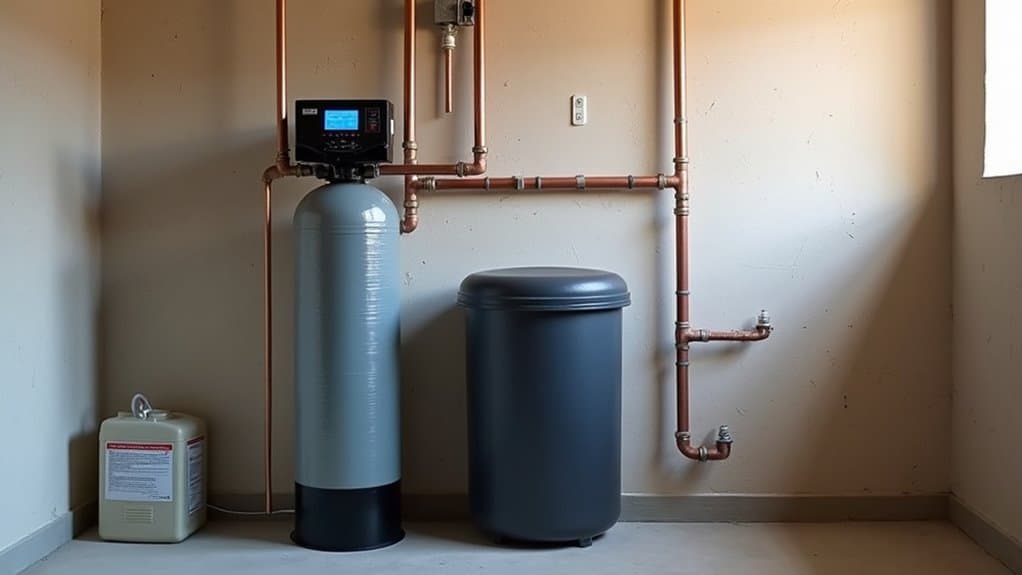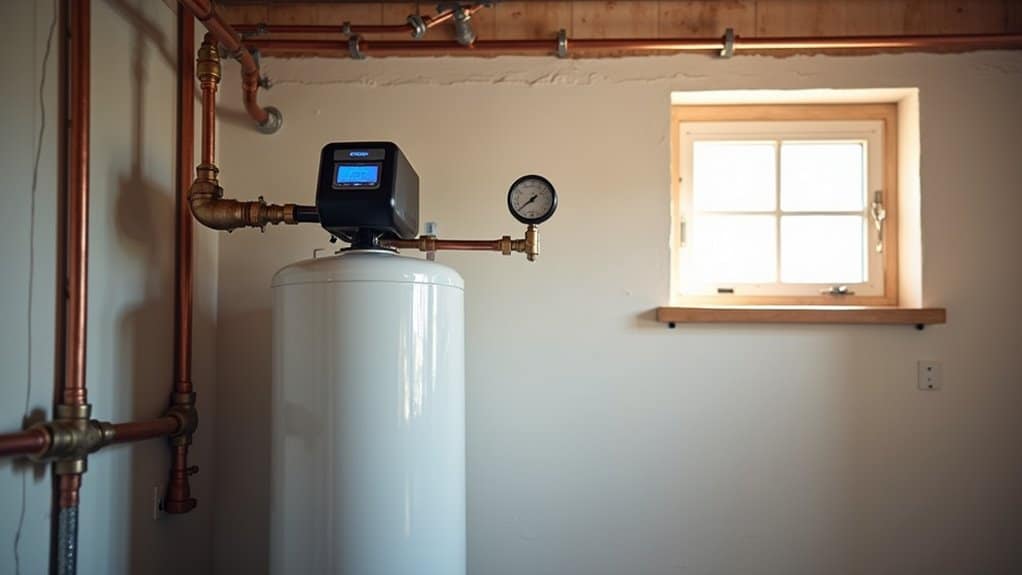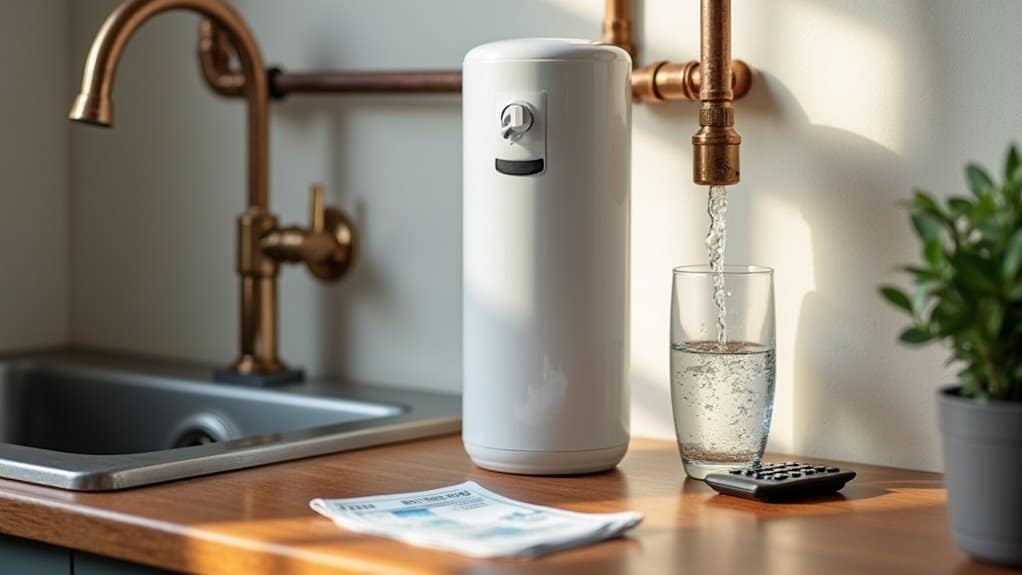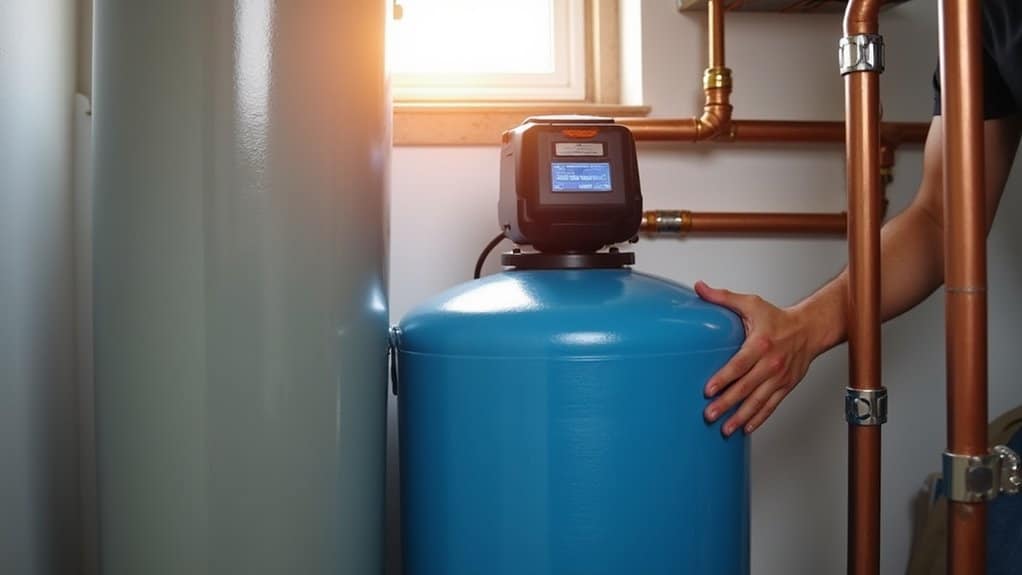A 40,000 grain water softener is ideal for 99% of American homes, efficiently serving households with 4-5 people and multiple bathrooms. These systems strike the perfect balance between capacity and efficiency, using 50% less salt and 28% less water than conventional models. We’ve found they provide optimal flow rates (5-10 GPM) while delivering economical operation with payback typically within 2 years. The right-sized system prevents costly appliance damage and unnecessary maintenance expenses.
Key Takeaways
- 40,000-grain capacity systems are ideal for most households with 4-5 people and 3-4 bathrooms.
- Systems should support flow rates of 10-12 GPM to handle peak usage when multiple fixtures operate simultaneously.
- Proper sizing prevents inefficiencies while reducing salt consumption by 50% and water usage by 28%.
- Matching the system to your home’s plumbing (¾-inch or 1-inch pipes) prevents pressure drops.
- Including a 25% safety margin when calculating required grain capacity ensures sufficient softening power.
Why 40,000 Grain Systems Are The Standard Choice

Four key factors establish 40,000 grain water softeners as the residential standard in America.
First, they provide optimal capacity for typical households (4-5 people, 3-4 bathrooms) with 15.5-20 GPM flow rates. The systems are IAPMO certified to NSF/ANSI Standard 44 for effectively reducing water hardness. Additionally, they are designed to maximize savings through tailored sizing, which enhances performance based on specific household needs.
Second, they balance efficiency with 50% less salt and 28% less water than conventional models.
Third, these systems deliver superior economic value—saving up to $497 annually through improved appliance efficiency while preventing scale buildup in plumbing.
Finally, they meet critical NSF/ANSI standards while accommodating both city and well water sources.
The 40,000-grain capacity represents the ideal intersection of performance requirements and long-term operational costs.
Matching Capacity to Household Size and Water Hardness

Selecting the optimal water softener capacity requires careful analysis of both household demographics and water chemistry profiles. We’ve found that matching grain capacity to household composition and water hardness levels prevents system inefficiencies. Additionally, using a quick calculation tool can simplify the process of determining the right capacity for your specific needs. Proper sizing also helps reduce salt and water consumption over the lifetime of your system.
| Household Size | Soft Water (0-3 gpg) | Moderate (4-7 gpg) | Hard (8+ gpg) |
|---|---|---|---|
| 1-2 People | 16,000 grain | 24,000 grain | 32,000 grain |
| 3-4 People | 24,000 grain | 32,000 grain | 40,000 grain |
| 5-6 People | 32,000 grain | 48,000 grain | 64,000 grain |
| 7+ People | 40,000 grain | 64,000 grain | 80,000+ grain |
For precise sizing, multiply: daily water usage × hardness level × 7 days, then add 25% safety margin.
Flow Rate Essentials for Modern American Homes

Flow rate represents one of the most critical yet frequently overlooked factors when sizing a water softener for American homes.
Most households require approximately 5 GPM during average use, but peak demand can surge to 10-12 GPM when multiple fixtures operate simultaneously. To ensure your system can handle these demands, it’s essential to consider the maximum flow rates of your specific appliances and fixtures.
To determine your needs, measure actual flow by timing how long it takes to fill a gallon container from a fully open faucet.
Then match your system to your home’s plumbing infrastructure—typically ¾-inch or 1-inch pipes—to avoid pressure drops. Always over-size slightly to accommodate high-demand scenarios like morning routines when showers, toilets, and kitchen fixtures run concurrently. Properly sized systems ensure sufficient ion exchange capacity to remove hard water minerals without requiring frequent regeneration cycles.
Cost Analysis: Balancing Investment With Long-Term Benefits

When weighing the financial impact of a water softener purchase, homeowners must consider both initial costs and long-term economic benefits. Standard ion-exchange systems range from $800-$2,500 installed, while premium options can reach $6,000. However, the average household saves $1,556 annually—primarily from reduced plumbing repairs ($122/month) and cleaning supplies ($1,053/year). Using an undersized water softener can lead to appliance damage and increased expenses, further emphasizing the importance of selecting the right size.
Most systems achieve payback within 20-26 months, delivering a substantial 51% cost reduction compared to hard water expenses. Monthly operational costs ($10-$20) and annual maintenance ($150-$900) maintain system efficiency, extending lifespan to 10-25 years with proper care. Dallas homeowners face particularly challenging conditions as the city’s mineral-rich reservoirs contribute to harder water and potentially higher maintenance costs without proper treatment.
Frequently Asked Questions
How Do Salt-Free Water Conditioners Compare to Traditional Salt-Based Softeners?
We find salt-free conditioners prevent scale through crystallization while preserving minerals, requiring no salt, electricity, or wastewater. Traditional softeners remove hardness minerals completely but consume salt, electricity, and generate brine discharge.
Can I Install a Water Softener Myself or Require Professional Installation?
We recommend DIY installation for homeowners with basic plumbing skills. You’ll save $200-500 in labor costs and maintain quality control, but complex setups may warrant professional installation for optimal performance.
How Often Should I Replace the Resin in My Water Softener?
We recommend replacing water softener resin every 10-15 years. However, high chlorine or iron levels, increased salt usage, or persistent hard water despite regeneration may necessitate earlier replacement.
Will a Water Softener Remove Harmful Contaminants Like Lead or Chlorine?
No, water softeners won’t remove lead or chlorine. They only target hardness minerals through ion exchange. For these contaminants, we recommend installing carbon filtration or reverse osmosis systems instead.
How Much Does Water Softener Maintenance Cost Annually?
We estimate annual water softener maintenance costs between $150-$350, including $60-$300 for salt, $40-$100 per service call, and possible component replacements ranging from $25-$400 depending on your system’s needs.
Conclusion
We’ve identified that 40,000 grain water softeners serve as the optimal solution for nearly all American households. By analyzing household size, water hardness levels, and required flow rates, we’ve determined this capacity provides the ideal balance of performance and efficiency. Our cost analysis confirms that while other sizes exist, the 40,000 grain system consistently delivers the most favorable long-term return on investment across variable water conditions.

Craig “The Water Guy” Phillips is the founder of Quality Water Treatment (QWT) and creator of SoftPro Water Systems.
With over 30 years of experience, Craig has transformed the water treatment industry through his commitment to honest solutions, innovative technology, and customer education.
Known for rejecting high-pressure sales tactics in favor of a consultative approach, Craig leads a family-owned business that serves thousands of households nationwide.
Craig continues to drive innovation in water treatment while maintaining his mission of “transforming water for the betterment of humanity” through transparent pricing, comprehensive customer support, and genuine expertise.
When not developing new water treatment solutions, Craig creates educational content to help homeowners make informed decisions about their water quality.


